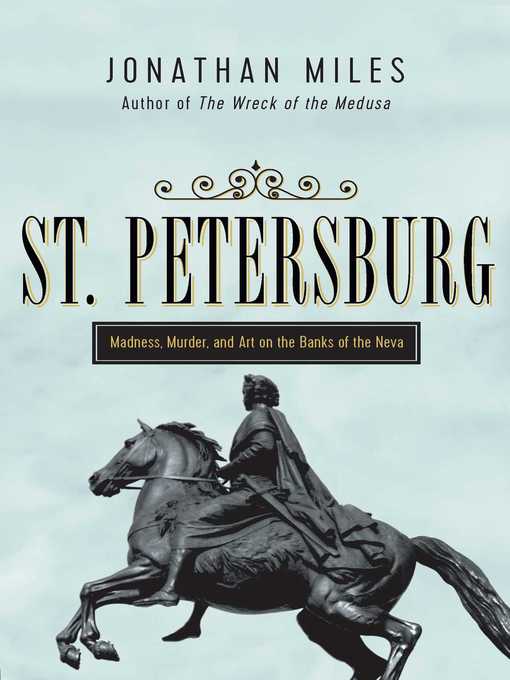
St. Petersburg
- اطلاعات
- نقد و بررسی
- دیدگاه کاربران
نقد و بررسی

January 15, 2018
Biographer and historian Miles (Nine Lives of Otto Katz) spans three centuries in this profile of St. Petersburg—a “dysfunctional” European city and “improbable” former capital. It’s a cluttered and skewed history; Miles delivers architectural details along with lurid tales of orgies on ice and other debaucheries of court life, while futilely attempting to tally the denizens who succumbed to disease, cold, and political terror. Miles juggles three themes: the “murderous desire” of St. Petersburg’s elite; a ruthless succession of secret police organizations; and the city’s compromised cadre of musicians, dancers, artists, and writers. Some of the latter, including Andrei Bely, Fyodor Dostoyevsky, Nikolai Gogol, and Nikolay Nekrasov, exposed the deprivation beneath the city’s gilded cupolas. But Miles’s lens is primarily that of an outsider and his analysis is simplified and colloquial. He describes in depth the opinions of foreign ambassadors, businesspeople, and tourists, yet the native Russians tend to blend into an undifferentiated mass. Miles visited the city in the 1990s and again two decades later, and goes so far as to suggest that the modern city is “in danger of sinking into the mire.” Unfortunately this work comes across as more empty hype than history. Illus.

January 15, 2018
"Peter's dream capital was majestic but crumbling, even as it was built": an expansive portrait of the calamity-laden urban center of European Russia.St. Petersburg--the city that would be known as Leningrad throughout most of the 20th century and then revert to its old name--is a city built on swampy ground. As Dostoevsky noted, it is "damp, foggy, rainy, snowy, fraught with agues, catarrhs, colds, quinsies [and] fevers of every possible species and variety." It has been the site of devastation and suffering and has spawned monstrous ideas and monstrous people, but it has endured, if improbably, and has even attained a certain majesty. Paris-based biographer Miles (The Dangerous Otto Katz: The Many Lives of a Soviet Spy, 2010, etc.) likens the city to New York in being a gathering place of strangers, foreigners, and people who wouldn't easily fit anywhere else. The author also uncovers a few ironies, such as the fact that some of the city's most impressive monuments were built by a French veteran of the Napoleonic Wars, who "submitted twenty-four different proposals in every known style, so it is hardly surprising that he won the commission." Chronicling shifting cultural styles, including Czar Alexander III's interest in making a more Russian city of his Russian capital, closing the popular Italian opera in the bargain, Miles turns in some familiar tales as well, populated by stock characters like Rasputin and Lenin. But perhaps not so familiar after all, since, as the author writes, the modern St. Petersburg is the city of the young, people for whom "the gulag is a distant epoch" and who are at home in the globalized era even if the Putin regime keeps them from realizing their potential. The author's account is vigorous and readable but a touch long; one wonders at what the economical Jan Morris might have done had she logged a few seasons in Russia.Readers with an interest in Russian cultural history and urban history will find much of value in these pages.
COPYRIGHT(2018) Kirkus Reviews, ALL RIGHTS RESERVED.

March 1, 2018
Miles (The Nine Lives of Otto Katz) writes a fascinating and rich history of the founding of St. Petersburg/Leningrad, beginning with 26-year-old Tsar Peter (Peter the Great) visiting the great cities of Europe, disguised as a workman, ready to learn shipbuilding and navigation from the "ground up." What Peter sees and learns in London, Amsterdam, and other places, he brings back to a Russia tied to tradition. It is the boundless drive and energy that Miles describes so well, that allowed Peter to see his vision come to life in St. Petersburg. Along with this vision came much death and destruction in the building of the city. Throughout the book, Miles undertakes to explore the Western art and architecture that influenced future leaders, especially the Romanovs. Some Russians in the mid-19th century were seeking democratic change; not seeing it in their own country. Miles effectively describes the beginnings of revolutionary transformation in St. Petersburg and the county as a whole with the coming of the 1917 Revolution. VERDICT The importance and the epic scale of St. Petersburg comes across vividly in this work. For all readers who enjoy Russian history combined with a rich overview of the arts.--Amy Lewontin, Northeastern Univ. Lib., Boston
Copyright 2018 Library Journal, LLC Used with permission.




دیدگاه کاربران